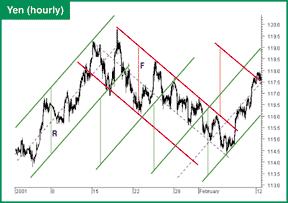CHARTING
Remember When
Affine Geometry Of The Markets
by Viktor Likhovidov
Think the market doesn't have a memory? Think again.
About five years ago, I came across an interesting article concerning the channeling behavior of market charts. I don't remember much about the article anymore, except for a method using "magic" parallel lines that seemed promising. I decided to try to derive useful trading signals from the idea with some simple geometric transformations.
PRICE CHANNELS AND MARKET MEMORY
In a nutshell, the premise is based on the following recommendation: When you find a good channel on a price chart, don't forget about it, because the market remembers such channels for a long time. At some point in the future, your chart will likely return to that same channel. But how can you "save" these channels effectively? One simple way is to plot parallel lines, setting the distance between them equal to the width of the channel.
In Figure 1 you see a display of two channels on the hourly chart of the spot yen. The first channel was formed in a rising market and is represented by two green lines; the vertical green segment denoted as R measures the height. The red channels mark falling prices and have a height of F. These parallel green and red lines (the distance between the green lines is determined by segment R, and between the red lines by F) form the consolidation lines that the market is going to "remember." This means that sometime in the future, even possibly quite distant from today's channels, the chart will meet one of those lines.

FIGURE 1: HOURLY CHART OF THE SPOT YEN. Two channels, January 2-February 7, 2001.
...Continued in the November 2002 issue of Technical Analysis of STOCKS & COMMODITIES
Excerpted from an article originally published in the November 2002 issue of Technical Analysis of STOCKS & COMMODITIES magazine. All rights reserved. © Copyright 2002, Technical Analysis, Inc.